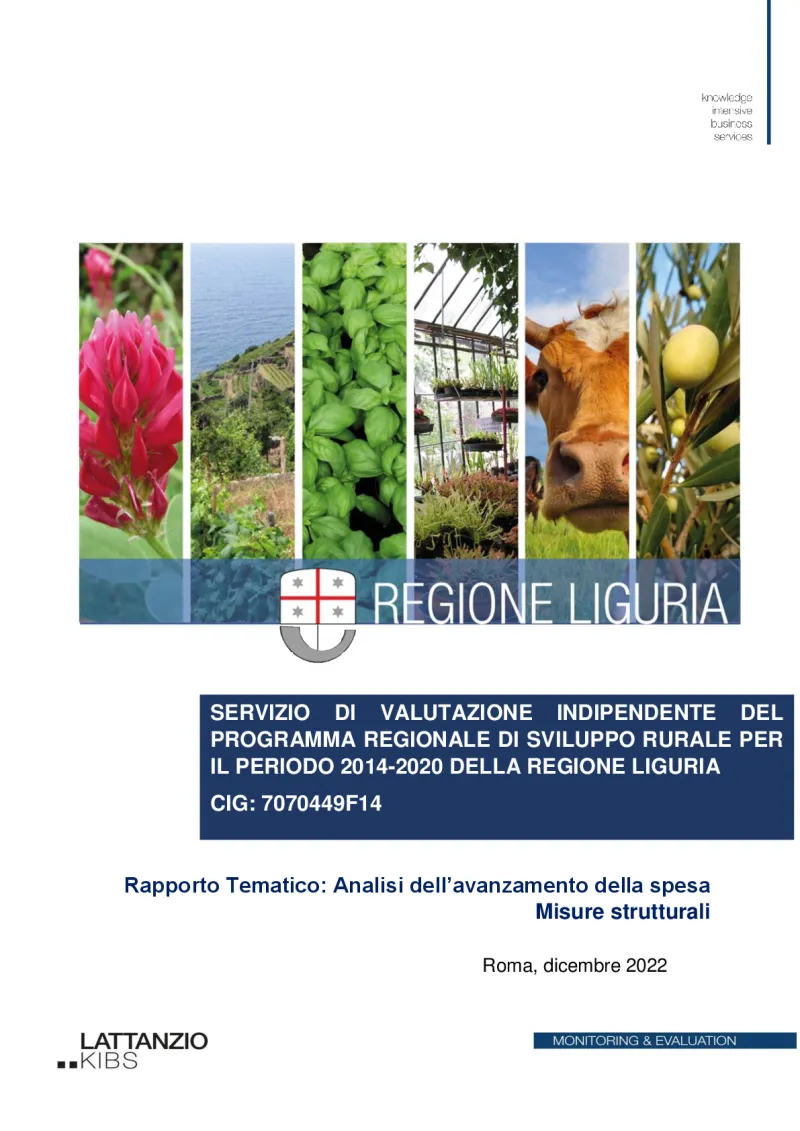Thematic report on the expenditure progress of structural measures
- Evaluation
- Jobs, Growth and Equality in Rural Areas
- Environment
- Agricultural Productivity
- Climate and Climate Change
- Evaluation
Given the recent difficulties in reaching an adequate level of expenditure in the Liguria region, the study aims to analyse the expenditure development of the non-area interventions.
- Italy
- 2014-2022
- Sectorial impacts


The evaluation is carried out in the framework of the independent evaluation service of the 2014-2020 Rural Development Programme (RDP) for the Liguria region. The report covers the period 2016-2022.
The purpose of the study is to analyse the expenditure development of the non-area interventions and assess the region’s ability to liquidate the committed resources to achieve RDP spending objectives. Liguria has always met expenditure objectives, but in recent years the Managing Authority has found increasing difficulties in reaching an adequate level of expenditure. The evaluation identifies both the intervention/type of beneficiaries facing the greatest difficulties in making payments and investigates any problem at the procedural/implementation level.
The methodological approach combines quantitative (e.g. statistics, monitoring data, etc.) with qualitative information analysis collected through CAWI (Computer-assisted web interviewing) and CATI (Computer-assisted telephone interviewing).
The work is carried out in the following steps. The first phase concerns the identification of evaluation needs with the participation of the evaluator and Managing Authority. It focused on reflecting on the time frame to be considered in the analysis.
The second phase was concerned with identifying useful primary and secondary data. It encompassed a more in-depth documentary analysis of official documents and different knowledge and research sources. The detailed analysis of regional monitoring data allowed for identifying the sub-measures and calls for tenders that encountered major difficulties in respecting the deadlines for the end of the works. The analysis of the physical and procedural progress was the basis for the subsequent qualitative analyses and the definition of three different profiles of beneficiaries. The samples (a proportional stratified sampling technique instead of basic sampling such as simple random sampling was chosen) for the surveys were identified, further distinguishing between public and private beneficiaries.
The evaluation concludes that in Liguria, the low weight of area-based measures, compared to non-area-based measures, significantly reduces the opportunity for beneficiaries of non-area measures to be able to rely on an adequate level of liquidity, given by the support linked to the areas measures, and useful to offset (or cover) the initial costs of farm investments.
Moreover, the expenditure analysis showed three main cases of beneficiaries lagging behind the deadline for operations completion.
First, beneficiaries submit late balance payment claims (31% of the analysed beneficiaries (4 420)). Among these, public beneficiaries are those experiencing the most significant difficulties. Only 10% manage to present payment claims of balance on schedule, while in the case of private beneficiaries, it comes to 74%.
Secondly, beneficiaries who, despite having requested interim payments, have not claimed the balance payment and are late in relation to the deadline. This category includes 441 beneficiaries (especially for Measures 16.1, 16.2, 16.4 and 7.1).
Finally, some beneficiaries have not submitted any payment claim, whose weight is limited (3.2%) but represents a critical factor for expenditure objectives.
Concerning the correlation between investments and delays, the analysis showed a direct proportional trend between investments and the percentage of late beneficiaries claiming payments. Small investments can meet the deadlines most frequently, while those requiring greater economic effort are often lagging.
The evaluation also concludes that 7% (295) of the support requests still have no balance payment claim and are lagging behind deadlines. The evaluator quantified the value of the projects affected by this delay at EUR 34 million, with an amount of EUR 19 million still to be liquidated. This figure represents a significant share of resources that can play a fundamental role in achieving the expenditure target for the Liguria RDP but is 'de facto' suspended due to the difficulties the beneficiaries encounter in complying with the deadlines set for the end of the works.
Finally, the results of the surveys (84 responses) highlight that, in general, the problem most addressed by surveyed beneficiaries is related to access to credit.
The effects of external events have been aggravated by the difficulties linked to availability/access to credit. As of the end of 2019, the entire region has been affected by environmental, social and economic shocks. The repercussions of these events are many, such as difficulties in buying machinery and equipment due to the unavailability of electronic components and double-digit inflation, a significant increase in energy costs, a higher cost of money caused by rising interest rates and the disappearance of some strategic export markets. In this context, farms have decreased their turnover, significantly increasing production costs and indebtedness rate. In addition, completing the procedures to accept support requests takes a long time.
Author(s)
LATTANZIO KIBS